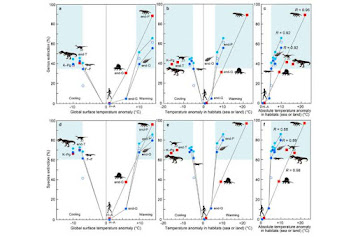The bigger the temperature change, the larger the extinction event, reveals researcher
A professor emeritus at Tohoku University has unearthed evidence pointing to a strong relationship between the magnitude of mass extinctions and global temperature changes in geologic times.
For more such news & interesting articles or how can it affect in your life subscribe to our newsletter.
The research was published in the journal Biogeosciences on July, 22, 2022.
Abrupt climate change, accompanied by environmental destruction from large volcanic eruptions and meteorites, has caused major mass extinctions throughout the Phanerozoic Eon—covering 539 million years to the present.
To date, there have been few quantitative evaluations of the relationship between land temperature anomalies and terrestrial animal extinctions. Moreover, marine animals and terrestrial animals have experienced divergent extinction rates, and this phenomenon remains under-explored.
Professor Emeritus Kunio Kaiho demonstrated that marine invertebrates and terrestrial tetrapods' extinction rates corresponded to deviations in global and habitat surface temperatures, regardless of whether it was cooling or warming. Loss of species during the "big five" major extinctions correlated with a > 7°C global cooling and a > 7-9°C global warming for marine animals, and a > 7°C global cooling and a > ~7°C global warming for terrestrial tetrapods.
"These findings indicate that the bigger the shifts in climate, the larger the mass extinction," Kaiho said. "They also tell us that any prospective extinction related to human activity will not be of the same proportions when the extinction magnitude changes in conjunction with global surface temperature anomaly."
Kaiho cites an earlier study, which claimed a 5.2°C temperature increase in average global temperature would result in a mass extinction event comparable to previous ones. Yet, based on this study's analysis, the temperature will need to change by 9°C, and this will not appear until 2500 in a worst-case scenario.
"Although predicting the extent of future extinctions is difficult because causes will differ from preceding ones, there is sufficient evidence to suggest that any forthcoming extinction will not reach past magnitudes if global surface temperature anomalies and other environmental anomalies correspondingly change," Kaiho said.
Kaiho also found a lower tolerance for terrestrial tetrapods than marine animals for global warming events. However, marine animals had a smaller tolerance to the same habitat temperature changes than terrestrial animals. This is because the temperature anomaly on land is 2.2 times higher than sea surface temperature. These phenomena fit ongoing extinction patterns.
Looking ahead, Kaiho seeks to predict future animal extinction magnitudes occurring between 2000-2500.
For more such news & interesting articles or how can it affect in your life subscribe to our newsletter.


Comments
Post a Comment